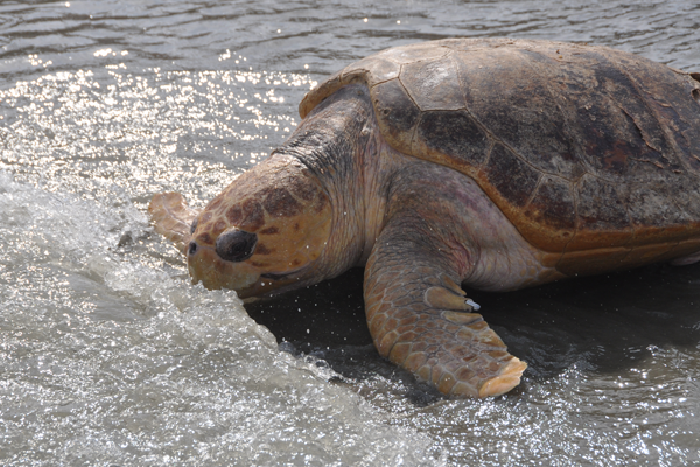With the Lowcountry beginning to transition from spring to summer, the warm sand, lively surf and salty air of Lowcountry beaches offer an environment of peace and play for locals and tourists alike. But humans aren’t the only ones flocking to the beach this time of year…
As you walk along the shoreline in the spring and summer months, have you ever spotted a roped-off area with an orange diamond sign? Chances are you came across a sea turtle nest! From May to mid-August, sea turtles (mainly loggerheads, our state reptile) come ashore to nest. About 60 days later, sea turtle hatchlings will emerge and make their way to the waves. Fun fact: Female sea turtles return to the same beach on which they hatched to lay the next generation of sea turtles!
The Nesting Process
The nesting process itself can last anywhere from one to three hours and requires a great deal of energy for the gravid (or egg-carrying) female. After using her flippers to pull herself above the high tide area on the beach, she picks a spot, then uses her back flippers to dig a nest in the sand that’s roughly 2 feet deep. From there, she lays her clutch, or group of eggs. Female sea turtles lay an average of 120 eggs per clutch and up to six clutches per nesting season!
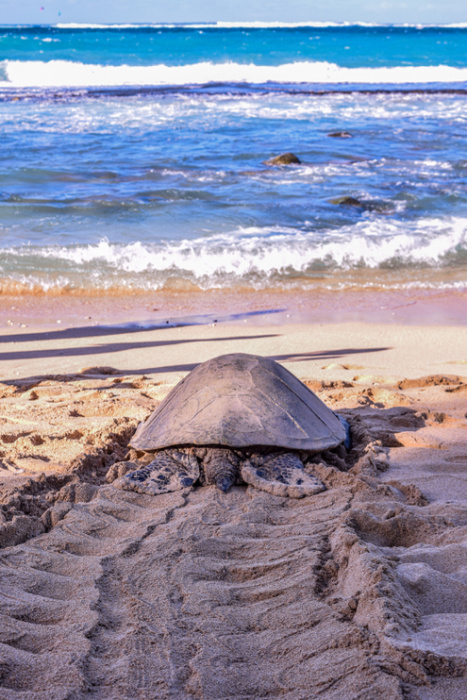 A female sea turtle makes her way back to the ocean after coming ashore to lay her clutch.
A female sea turtle makes her way back to the ocean after coming ashore to lay her clutch.When the turtles start to hatch, they create what resembles a boiling pot of water, which is why a hatching nest is sometimes referred to as a “boiling.” One after another, the hatchlings surface from under the sand and make their way towards the ocean and into the waves. They’ll swim upwards of 60 miles to reach a float of sargassum (a type of seaweed that floats on the water’s surface), where they spend their young years hiding from predators and maturing to adulthood.
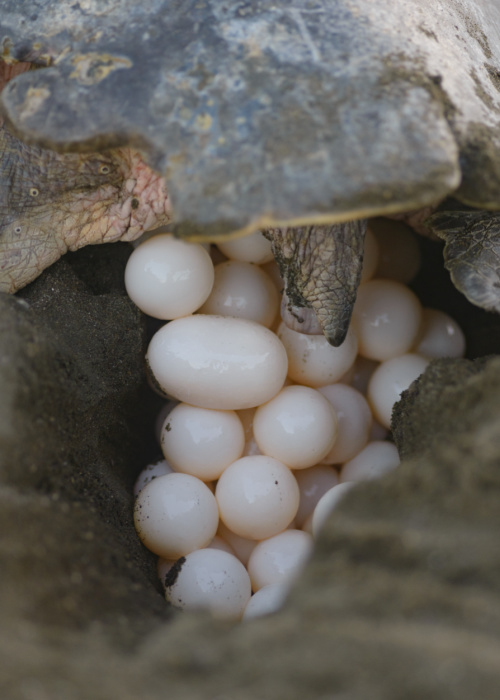 The sex of a sea turtle is determined by the temperature of the sand that the eggs are incubated in. Warmer sand yields females while cooler sand produces males.
The sex of a sea turtle is determined by the temperature of the sand that the eggs are incubated in. Warmer sand yields females while cooler sand produces males.Clutches in the Sea Turtle Care Center™
While this is the case for most sea turtles during nesting season, we’ve had two standout loggerhead patients in the Care Center who actually laid clutches while in our care: Mama Pritchard and Awendaw. We were able to talk with Cait Crosby, senior sea turtle biologist, and Melissa Ranly, Sea Turtle Care Center manager, to learn more about these two former female patients.
Mama Pritchard was admitted to the Care Center in July 2008 when a nesting team spotted her on Pritchard’s Island, South Carolina attempting to nest. She had two significant boat strike wounds on the rear of her carapace, and she was covered in mud and barnacles. By October 2008, three months after admit, Mama Pritchard deposited eggs three separate times in her holding tank for a total of 146 eggs.
Awendaw came to us in May 2016 after a U.S. Fish and Wildlife volunteer discovered her on Bulls Island, an important nesting beach in the Cape Romain National Wildlife Refuge. She had sustained severe propeller wounds to her shell; a large portion of her caudal (rear end) carapace was missing and a substantial section remained only loosely attached. After being admitted and placed into a tank to rest and recover, Awendaw laid two eggs later that day. She continued depositing eggs until mid-August, laying two to three eggs per day in her tank.
When a female in our care lays eggs, our staff quickly fetches them from the tank and keeps them covered and secure until the South Carolina Department of Natural Resources (SCDNR) team can retrieve the eggs.
Help Our Nesting Sea Turtles
You can make a difference this nesting season! These simple but impactful actions can help improve the chances of survival for sea turtle hatchlings:
- Fill in any holes on the beach
- Pick up any trash and all of your belongings on the beach when you leave
- Turn off exterior lights in the evenings, and use a red flashlight if you take an evening walk
- If you encounter a nesting sea turtle or hatchling, don’t approach them, but give them plenty of space and do not disturb them
- If you see a sea turtle in need of assistance, call SCDNR at 1 (800) 922-5431 (save this number in your phone!)
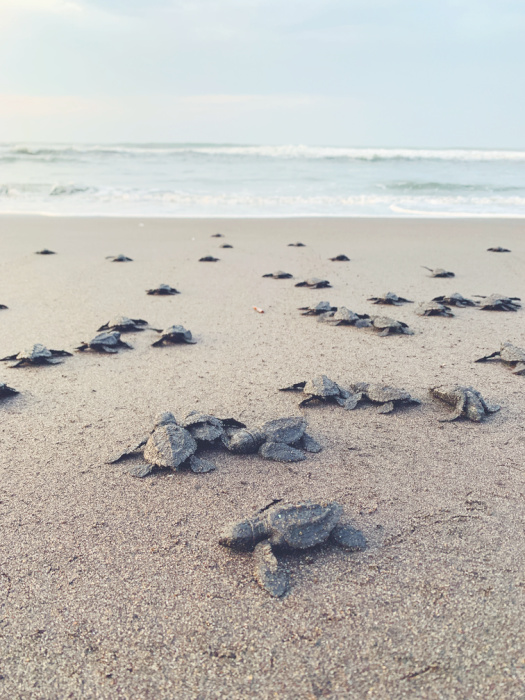 After a boiling, hatchlings make their way to the ocean using natural light to guide their way.
After a boiling, hatchlings make their way to the ocean using natural light to guide their way.As nesting season kicks off, keep an eye out on the beach for our beloved loggerheads! You never know when you may encounter a mama loggerhead helping bring about the next generation of sea turtles.
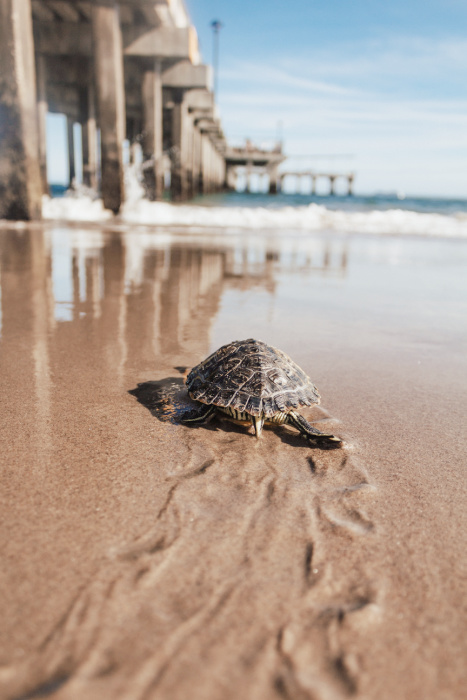 Females may spend over two hours out of the water during the nesting process.
Females may spend over two hours out of the water during the nesting process.Connections in Sea Turtle Conservation
We previously wrote about flipper and PIT tagging, and our very own Mama Pritchard is a great example of why tagging is so important. When Mama Pritchard was first encountered nesting in 2002, she was flipper and PIT tagged. Just two years later, she was discovered again while nesting and was identified by her tags. Four years later, Mama Pritchard was stranded and found by nesting teams who scanned her PIT tag, identified her and then brought her to the Care Center for rehabilitation.
Additionally, we talked about a genetics study to further research sea turtle lifespans using sea turtle egg DNA. When Mama Pritchard was in our care in 2008, SCDNR collected a DNA sample from her. Using this sample, SCDNR was able to match Mama Pritchard’s DNA to nests on Pritchard’s Island in 2013 and 2019!
Mama Pritchard is a perfect example of how scientific advancements and research methods enabled us to tag and identify a nesting female who has also undergone rehabilitation, confirming a successful outcome across two decades.
A special thank you to our experts, Melissa Ranly, Sea Turtle Care Center manager, and Cait Crosby, senior sea turtle biologist, for their time and knowledge in creating this blog.
Do you have another question for our experts?
Published April 29, 2022


